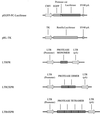Development of a novel screen for protease inhibitors
- PMID: 11238235
- PMCID: PMC96076
- DOI: 10.1128/CDLI.8.2.437-440.2001
Development of a novel screen for protease inhibitors
Abstract
We have developed a novel plasmid-based, quantitative, in vitro screen to test the protease-inhibiting activities of existing and newly discovered agents.
Figures



Similar articles
-
Non-infectious fluorimetric assay for phenotyping of drug-resistant HIV proteinase mutants.J Clin Virol. 2006 May;36(1):50-9. doi: 10.1016/j.jcv.2006.01.014. Epub 2006 Mar 9. J Clin Virol. 2006. PMID: 16527535
-
A new strategy based on recombinant viruses as a tool for assessing drug susceptibility of human immunodeficiency virus type 1.J Med Virol. 2007 Feb;79(2):127-37. doi: 10.1002/jmv.20770. J Med Virol. 2007. PMID: 17177310
-
Cross-resistance within the protease inhibitor class.Antivir Ther. 2001;6 Suppl 2:29-36. Antivir Ther. 2001. PMID: 11678476 No abstract available.
-
A hierarchical model of HIV-1 protease drug resistance.Appl Bioinformatics. 2002;1(1):3-12. Appl Bioinformatics. 2002. PMID: 15130852 Review.
-
Adaptive inhibitors of the HIV-1 protease.Prog Biophys Mol Biol. 2005 Jun;88(2):193-208. doi: 10.1016/j.pbiomolbio.2004.07.005. Prog Biophys Mol Biol. 2005. PMID: 15572155 Review.
References
-
- Babe L M, Craik C S. Viral proteases: evolution of diverse structural motifs to optimize function. Cell. 1997;91:427–430. - PubMed
-
- Marcel V, Estrada-Mondaca S, Magne F, Stojan J, Klaebe A, Fournier D. Exploration of the Drosophila acetylcholinesterase substrate activation site using a reversible inhibitor (Triton X-100) and mutated enzymes. J Biol Chem. 2000;275:11603–11609. - PubMed
-
- Molla A, Vasavanonda S, Kumar G, Sham H L, Johnson M, Grabowski B, Denissen J F, Kohlbrenner W, Plattner J J, Leonard J M, Norbeck D W, Kempf D J. Human serum attenuates the activity of protease inhibitors toward wild-type and mutant human immunodeficiency virus. Virology. 1998;250:255–262. - PubMed
MeSH terms
Substances
LinkOut - more resources
Full Text Sources
Other Literature Sources
Medical

